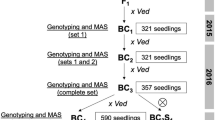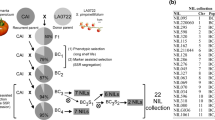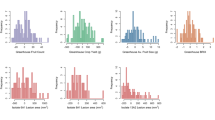Abstract
In a tomato (Lycopersicon esculentum) breeding programme aimed at earliness, a breeding line, designated ‘IVT-KT1’, was developed by several rounds of crossing and selection. Among its ancestors were the two wild relatives L. pimpinellifolium and L. parviflorum. The breeding line flowered and set fruit one to four weeks earlier than old and modern cultivars. To identify QTLs for earliness, an F2 population was obtained by crossing ‘IVT-KT1’ with the ‘late’ true breeding cultivar ‘Premier’. In winter and early spring, 690 plants of this F2 population were evaluated for earliness of which 292 were selected for RFLP analysis. Only limited parts of the genomes of ‘IVT-KT1’ and ‘Premier’ were polymorphic and these polymorphisms were likely due to introgression from the ancestor wild species. By using the interval mapping method on the combined data of the greenhouse evaluations and RFLP analyses, three loci were identified that were associated with earliness. One was mainly associated with flowering time, another with fruitset time and a third one with ripening time. Two of these loci were also associated with fruit weight. F3 progenies selected for earliness on the basis of the QTL-data did confirm the F2 results. Two major earliness genes explained a difference in earliness of more than three weeks. The association with reduced fruit weight seemed to be due to pleiotropic effects rather than to linked genes. Consequently, the gain in earliness will cause a reduction in fruit weight that may not be acceptable for breeding applications.
Similar content being viewed by others
References
Baggett, J.R. & W.A. Frazier, 1978. Oregon cherry tomato. Hort. Sci. 13: 598.
Banerjee, M.K. & Kalloo, 1989. The inheritance of earliness and fruit weight in crosses between cultivated tomatoes and two wild species of Lycopersicon. Plant Breeding 102: 148–152.
Ciovanonni, J.J., R.A. Wing, M.W. Ganal & S.D. Tanksley, 1991. Isolation of molecular markers from specific chromosomal intervals using DNA pools from existing mapping populations. Nucl. Acids Res. 19: 6553–6558.
Kemble, J.M. & R.G. Gardner, 1992. Inheritance of shortened fruit maturation in the cherry tomato Cornell 871213–1 and its relation to fruit size and other components of earliness. J. Am. Soc. Hort. Sci. 117: 646–650.
Kooistra, E., 1968. Breeding for early yield in glasshouse tomatoes. Hort. Sci. 3: 253–256.
Lander, E.S. & D. Botstein, 1989. Mapping mendelian factors underlying quantitative traits using RFLP linkage maps. Genetics 121: 185–199.
Michelmore, R.W., I. Paran & R.V. Kesseli, 1991. Identification of markers linked to disease resistance genes by Bulked Segregant Analysis: a rapid method to detect markers in specific genomic regions by using segregating populations. Proc. Natl. Acad. Sci. USA 88: 9828–9832.
Miller, J.C. & S.D. Tanksley, 1990. RFLP analysis of phylogenetic relationships and genetic variation in the genus Lycopersicon. Theor. Appl. Genet. 80: 437–448.
Nieuwhof, M., G. Pet & F. Garretsen, 1987. Inheritance of characters determining growth and development of tomato (Lycopersicon esculentum Mill.) under low energy conditions. Euphytica 36: 205–213.
Stam, P., 1993. JoinMap: a computer package to construct integrated genetic linkage maps. Plant J. 3: 739–744.
Tanksley, S.D., M.W. Ganal, J.P. Prince, M.C. Devicente, M.W. Bonierbale, P. Broun, T.M. Fulton, J.J. Giovanni, S. Grandillo, G.B. Martin, R. Messeguer, J.C. Miller, L. Miller, A.H. Paterson, O. Pineda, M.S. Roder, R.A. Wing, W. Wu & N.D. Young, 1992. High density molecular linkage maps of the tomato and potato genomes. Genetics 1324: 1141–1160.
Van der Beek, J.G., R. Verkerk, P. Zabel & P. Lindhout, 1992. Mapping strategy for resistance genes in tomato based on RFLPs between cultivars: Cf9 (resistance to Cladosporium fulvum) on chromosome 1. Theor. Appl. Genet. 84: 106–112.
Van Ooijen, J.W., 1992. Accuracy of mapping quantitative trait loci in autogamous species. Theor. Appl. Genet. 84: 803–811.
Author information
Authors and Affiliations
Rights and permissions
About this article
Cite this article
Lindhout, P., Van Heusden, S., Pet, G. et al. Perspectives of molecular marker assisted breeding for earliness in tomato. Euphytica 79, 279–286 (1994). https://doi.org/10.1007/BF00022528
Issue Date:
DOI: https://doi.org/10.1007/BF00022528




